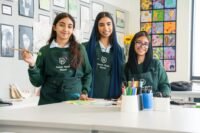A good blend of in-person and digital learning is expected to shape the teaching mechanism for the long term
Dubai, Oct 05, 2021: As the world celebrates Teachers’ Day, teachers from the UAE share their experiences of working amidst the pandemic on how the immediate need for remote learning forced them to adapt innovative methods. From teachers being largely unprepared for a complete transition from traditional mode to web-based classes and virtual meetings to adapting to hybrid teaching, there is a wide range of responses on how the pandemic has changed teaching for them.
With schools in the UAE getting back to face-to-face learning, teachers are of the view that the skills developed during the pandemic will give more flexibility and efficiency to both students and teachers in the learning process. A good blend of in-person and digital learning is expected to shape the teaching mechanism for the long term.
Larissa Milne, Head, Teaching and Learning. MYP Individuals & Societies, DP History & DP Global Politics Teacher, Dwight School Dubai

The pandemic has definitely made teaching more focused on digital technologies. Even though we are now back in the classroom, activities that we used to do via paper and printing are now digital, through platforms such as Google Docs etc. And although this transformation has been great in terms of innovation and creativity and engagement for students, it has also had a negative impact. Students now are more comfortable with typing and online platforms than writing and paper. We as teachers now need to make a conscious effort to ensure students’ experience and practice handwriting, in an effort to inculcate and encourage that skill. In addition, the way in which we collaborate within the classroom has changed. Social distancing has meant that students are limited to the amount or type of group work that they do. I think the key now as educators, moving towards a post pandemic world is that we grab hold of the new technologies that have been opened to us during the pandemic, but not forget some of the traditional teaching strategies that are still important and relevant today, that were maybe lost during the pandemic and online learning.
Helen Scott, Head of English, Repton Abu Dhabi

The pandemic has spurred me on as a teacher to think outside of the box, it has developed my ability to be adaptable and made me crave opportunities to collaborate creatively with colleagues.
The biggest changes from the pandemic on my teaching methodology, beyond an increased focus on the wellbeing of my students, has been a shift back to a student-centered approach to learning. Some strategies implemented to assist this change have been: the introduction of free choice ‘Do Now’ retrieval practice starters to increase memory recall; ensuring critical thinking opportunities feature in every lesson; making use of cold calling, open-ended and higher order questioning techniques; and encouraging as much student collaboration as possible.
After months of teaching with little face-to-face interaction, it is time for us to focus on building oral literacy skills, as well as a sense of community through student interaction in our classrooms.
Reena Oates, Secondary Deputy Headteacher, Star International School, Mirdif

Teaching has evolved during the pandemic and hybrid teaching is now something that is ‘normal’ for all teachers. Using tools such as Google Classroom and Zoom at the start of pandemic was a necessity, nevertheless they are now tools to personalise learning and create resources for students to access learning at their own pace. I definitely prefer face to face learning but can now see a place for technology to enhance teaching and learning.
Mary Rossi, Grade 2 Homeroom Teacher, Dunecrest American School

This pandemic served as a catalyst in the evolution of my teaching practice. My knowledge of using technology grew tremendously in order to create a successful virtual learning environment for students. My collaboration skills were forced to strengthen not only between colleagues and administration but also with families which inevitably formed a nurturing support system between us all.
Eric Barrett, IBDP Coordinator/English, Dunecrest American School

The pandemic has fundamentally changed how teachers and students view access to learning and teaching. We have all been empowered through this hardship, and the learning process will grow into a modern setting that utilizes 21st-century tools. While I still believe in the efficacy of face-to-face learning, it’s my hope that our teachers and students have come to understand how technologies can serve our needs and advance our educational aims.
Matt Backus, Technology Teacher, Dunecrest American School

The biggest change in teaching and learning due to the COVID-19 pandemic has been the increased use of technology. Yes, it has always been there, with different levels of adaptation depending on the teacher and the subject matter. The pandemic forced us all online, in front of our laptops and iPads, to continue learning for months, exclusively through the use of technology. The amount of learning and upskilling for both teachers and students in the use of technology in a very short time was simply remarkable. Zoom class meetings, online work submissions, electronic resources, and remote group collaboration became the norm. Everyone rose to the new challenge, and new and exciting applications of our technology surpassed any possible expectations and is what made learning in the year 2020 continue to be a success. Now that we are back in the classroom where face to face learning has resumed, new skills and methods developed during the pandemic are still present giving more flexibility and efficiency to both students and teachers in the learning process.
Samantha Yousef, Grade 5 Homeroom and ELA Teacher, Dunecrest American School

One thing that I learned from the pandemic is how truly versatile teachers can be. Overnight we had to become experts at online teaching and had to learn how to engage our students over a Zoom lesson. The students had to adjust to learning from home and it was not easy for many. Submitting work online for feedback was something so new for the students too. It was a big change for everyone. Then we had the privilege of coming back to school and again it had its challenges, as we wore masks. We have learned so much through this time. The most valuable lesson was the truth in the old adage, “Where there is a will, there is a way.”
Dr. Soledad Valenzuela, International Assessment Coordinator / ELL Coordinator, Dunecrest American School

The pandemic has definitely impacted teaching. It has moved education from a model that was almost exclusively face-to-face to a model that is highly technology driven in which the Internet and electronic devices play a key role to connect with students, communicate, and deliver content. A wide range of online learning platforms were made available to educators during the pandemic and many schools worldwide used them with varying degrees of effectiveness. These resources were critical for schools to continue operating and for teaching and learning to happen, to a point that many have pondered the probabilities of eventually transitioning into a fully online system. Though education may have expanded in its delivery forms, I believe human interaction continues to be essential for effective teaching/learning and for the full development of our students. Education continues to be a “people business!”
Louise Lee, Primary Years Teacher, Fairgreen International School

The pandemic brought many challenges for teachers across the globe. For me, the biggest challenge was organizing lessons where students had to stay seated at their desks and socially distant from their peers and teachers. As a huge fan of collaborative visible thinking routines and game based learning activities, I had to think on my feet. As with all challenging times, the pandemic helped me grow and learn as a practitioner. As a result of it, I have become more proficient with the use of technology to enhance learning within the classroom and more creative in my ability to problem solve effectively.
Danel Schultz, Grade 1 Learning & Teaching Lead. Raha International School, Khalifa City Campus

As an educator, I have always been dependent on the relationships I build with children in my class. When the pandemic started, the hardest aspect for me to overcome was attempting to continue to do this, while my children weren’t physically in front of me. I felt like I had to check-in with my children almost 24/7 to make sure that they were okay and doing well emotionally. I think teaching during the pandemic has developed my problem-solving skills, taught me to be more resilient, to adapt and to be flexible to all areas of teaching and learning.
Dr. Sanja Vicevic Ivanovic, PYP Curriculum Coordinator, Greenfield International School

A huge area of impact has been how students and teachers have communicated and interacted through the different online platforms.
Even before the pandemic we used technology to collate and showcase student work – mainly as a digital portfolio for sharing. However, during the lockdown, and now returning to school, it has been used much more as an interactive tool for sharing, storing, -creating content, assessment and feedback As a foreign language teacher, I saw technology being adopted as an interactive notebook suitable for fostering all four language skills, listening, reading, speaking, and writing. It is a strong indication that foreign language learning will go paperless, even with the youngest students who have really flourished with their ICT skills.
Ms Gemelyn Palo, I & S Teacher and Extended Essay Lead, Greenfield International School

These unprecedented circumstances pushed me to evaluate the 3Rs in my teaching framework. First, RETHINKING OF INSTRUCTION – to ensure that my teaching strategies are more personalized to the needs not only of the students in front of me but as well as the ones in their virtual learning environment. REFLECTING ON THE PURPOSE OF THE CURRICULUM – it motivated me to conduct an on-going review of the curriculum to ensure that it remains relevant, meaningful and accessible. Finally, RESPECTING THE STUDENTS – this pandemic has taught me to be more sensitive and respectful to every situation and the different stresses and strains that our students are going through because of the pandemic. Teaching during pandemic has taught me to become more flexible, adaptive and open to changes.
Ben Fox, Head of Year 5 & Head of Teaching & Learning, Repton Al Barsha

The recent pandemic caused me to adapt my teaching methodologies and develop an arsenal of new digital competencies. The main revisions I had to make as a primary teacher were how I engaged pupils and how I provided quality feedback for them during lessons both online and in the classroom. I found that the new hybrid learning environment was to be negotiated using enquiry led learning with the pupils safely working collaboratively using their own innovative digital skills. The feedback element of learning has become more fluid and children are able to enhance their work in a variety of ways and extend their learning further.
Sharon Robertson, FS1 Class Teacher, Horizon English School

The pandemic has had a profound impact on my teaching pedagogy. Initially it felt like an unplanned experiment that required me to respond quickly without the necessary resources. Then through conversation, relationships, reflections and calmness it forced me to identify what was important, what could I manage and provide. That’s when it became easier to provide a calm enabling environment. Within bubbles, I was still able to provide open-ended playful teaching and create opportunities for the children to be actively engaged,. While progress and attainment is important, it is worth nothing if children are not happy, healthy life-long learners, within the magical world of Early Years education. It has pushed me back into ‘play’, ‘play’ and more ‘play’, as the centrality of how play supports children to learn is phenomenal.
Scott Wilkinson, Year 6 Homeroom Teacher & Head of Year 5 & 6, Newlands School, Dubai
 The pandemic has changed the way I view a classroom, in the traditional sense. It is no longer confined to four walls where students sat in groups or rows facing a teacher. Technology has enabled students to access high-quality learning from wherever they are in the world in real-time, allowing teachers to interact, guide and support them in ways we never thought possible.
The pandemic has changed the way I view a classroom, in the traditional sense. It is no longer confined to four walls where students sat in groups or rows facing a teacher. Technology has enabled students to access high-quality learning from wherever they are in the world in real-time, allowing teachers to interact, guide and support them in ways we never thought possible.
Hannah Onafuye, Head of Science, Reach British School

The pandemic has meant that it’s much harder to personalise learning. Teaching is based so much on relationships and the pandemic has meant that a lot of the interactivity of teaching has had to be removed. This has definitely had an impact on the way we build relationships with students. Even now the day-to-day strategies to make lessons engaging are not as effective due to COVID 19 distancing protocols.
Usman Iqbal, Year 3 Leader and Class Teacher, Reach British School

The pandemic has caused us to inadvertently rethink education delivery. We found out that in such a technologically driven world, the tools we used as educators to empower our students and the ways in which we promoted independence, collaboration, creativity and uses of technology, were a step behind. To reevaluate and then actively encourage the use of technology as a driver to the future, has been a breath of fresh air.
Michael Bradbury, Head of Computer Science, GEMS FirstPoint School – The Villa

When the pandemic hit, I had to rethink my whole approach overnight and seek more innovative methods to support my students to work together. With all students now returning, I have further refined my use of digital technology and integrated these methods to enhance my practice.”
Clare Boyes, Teacher & IB Coordinator, Kent College Dubai

During the pandemic and distance learning, it was important that students could not only access learning activities and resources but that their emotional, social and mental needs were met. The development of innovative online platforms and resources was quick as was necessary to meet the urgent need. We’ve been open for face-to-face learning for a full academic year now, and have since been able to reflect on how education has developed and seek opportunities to use the online platforms to enhance educational experiences.
Lauren Craig, Head of Year Six, Horizon English School

Social-distancing, and other measures that have been introduced to ensure safety have made communication between pupils much more challenging. As a result, as teachers we have had to carefully consider how we can structure these opportunities to ensure our learners don’t miss out. The use of iPads and other technology has supported this enormously.
We have been using what we know about education but also working from gut instinct to give our pupils the best possible outcomes. This has made things difficult, but also extremely rewarding. As a teacher, I have gained an increased appreciation for the resilience of my pupils – they have been a support for their teachers (often unbeknownst to them!) in the most difficult circumstances many of us have faced.
Bryan Cahil, Head of Year 4, Arcadia School

In order to successfully adapt to online learning, I was required to improve my understanding and use of technology to support learning and this continues to benefit me now that we are back in the classroom. My teaching has further shifted away from the heavy use of physical resources and paper to digital resources and applications. The pandemic also gave me time to think about my practice, trying to unpick different aspects of my teaching. I found myself questioning the benefits and efficacy of certain strategies I had frequently used in order to try and improve my practice and the outcomes of the children that I teach. Finally, I feel that the pandemic has raised the levels of appreciation that teachers feel from everyone in the community. While always supportive, I have noticed a further increase in the levels of trust and appreciation given to teachers since the pandemic and, in particular, online learning began.
Greg Clayton, Year 6 Teacher and Head of Year 5 and 6, Brighton College Dubai

Although I frequently use various technologies in my classes, this period has forced me to work outside of the box and use technology that I had not previously used as part of my classes. Remote learning has served as a vehicle for me to become a more well-rounded teacher, and it has opened my eyes to the extremely difficult situations that some of our students face. It also has given me a new appreciation for the simple ability to go into work and be with my students and colleagues.
Rebecca Meads, Year 2 Teacher and Head of Year 1 and 2, Brighton College Dubai

Over the past year, our educators have shown their adaptability and dedication to delivering first class education with the introduction of a hybrid method for teaching. With technology having some unavoidable challenges, our teachers have accomplished so much in continuing to shape independent, responsible and flexible learners. As the world returns to in-school learning, I hope that educators across the globe continue to see just how amazing they are.
Meabh Rohan, Year 3 Teacher, Brighton College Dubai

Over the past year teachers have been required to think (even more) outside the box to engage children in a meaningful way despite being restricted by mask wearing and social distancing, while often simultaneously having some children learning online. While teachers have had to be innovative, so too have children had to adapt and adopt a more resilient and independent attitude. We have all been challenged, but our scope of teaching skills has improved greatly because of the challenges we have faced and overcome.
Agata Hartly, Senior Leadership Member, Star International School, Al Twar

Education is continuously evolving, but with the pandemic descending on the world, education has had to take a leap of faith toward technology. We feel that adapting to the E-Learning model is the only way forward to maintain continuity of education. The success of any e-learning model, especially at primary and secondary school level, depends on finding the right balance between a self-paced (asynchronous) and a collaborative (synchronous) form of instruction. To facilitate student learning, we have pushed to create a structure, taking the best elements of both.
Chris Buswell, Director STEM & Upper Primary Science/ Maths Teacher, Australian International School
We have many children who have been away from friends and / or school for a long period so our focus to start the year has been on ensuring children are developing connections face to face with other children, sharing stories and enjoying learning back in schools. Teachers have also focussed efforts on literacy, handwriting, number skills, particularly in the early years to ensure fine motor and thinking skills are well developed as we move into learning for the year.








